Residual current device (RCD)
It is not quite clear when and by whom the first residual current device (RCD) was developed, but it certainly appeared on the market in the 1950s and was initially used by some utility companies to fight “energy theft” due to the use of currents from phase to earth instead of phase to neutral.

RCDs are now widely used in most of the world, in some cases this is required, while in others their use is optional.
I assume that you already know the working principle of residual current device, so the main focus will be on the classifications according to RCD’s functions and features and on the other hand – wave form of earth leakage currents RCD can detect.
The following devices are all RCDs, equipped with additional functions and features, offering cost effective solutions in different applications.
Criteria I – Additional functions and features:
- Residual current circuit breaker (RCCB)
- Residual current circuit breaker with overload protection (RCBO)
- Earth leakage circuit breaker (ELCB)
Criteria II – Wave form of earth leakage currents detected: (see details)
- Type AC
- Type A (alternating and/or pulsating current with DC components)
- Type A (pulsating, smooth and alternating residual sinusoidal currents up to 1KHz)
- Type F (for installations when frequency inverters)
Additional RCD types: (see details)
- Type F
- Type B+
Residual current circuit breaker (RCCB)
This device is essentially a mechanical switch with the residual current tripping characteristic attached to it. So basically it will only break the circuit when there is a leakage current flowing to earth. The tripping time is such as to minimise the risk to human life.
RCCBs usually have a fault making and breaking capacity on the order of 1 kA. This means that they can handle a fault of 1 kA on their own if it is a fault to earth.


For overloads and line to neutral short circuits, the Wiring Rules require other devices to provide protection. The device used for short circuit protection may improve the short circuit rating of the RCCB when they operate together. This allows an RCCB rated at, for example, 1000 A to be used in circuits where the actual fault level is higher than 1000 A!
In summary // RCCBs provide earth leakage protection, however a major point to remember when applying them is that they must always be installed in conjunction with an appropriately rated Short Circuit Protective Device (SCPD).
Residual current circuit breaker with overload protection (RCBO)
This is a residual current device that has an MCB built in to it. Effectively, the RCBO is the equivalent of an RCCB + MCB. The main functions that an RCBO is able to provide are:
- Protection against earth fault currents
- Protection against overload and short circuit currents
As the price of these devices is falling, the RCBO is an effective way of protecting lives and the installation.


Earth leakage circuit breaker (ELCB)
This kind of residual current device has been designed to satisfy the requirements of industry. They suit three-phase circuits and high current loads. The residual current threshold and tripping delay is often adjustable, thus allowing selectivity among different circuit breakers.
Phase and neutral conductors go through a toroidal transformer, creating a magnetic field proportional to its current.
In normal situations the vector sum of the currents is zero. In case of fault, the toroidal transformer detects the imbalance and sends a signal to the relay and compares it with the preset threshold value. The output contact of the relay is turned on when the fault detected value is higher than the preset threshold and lasts more than the preset tripping time value.
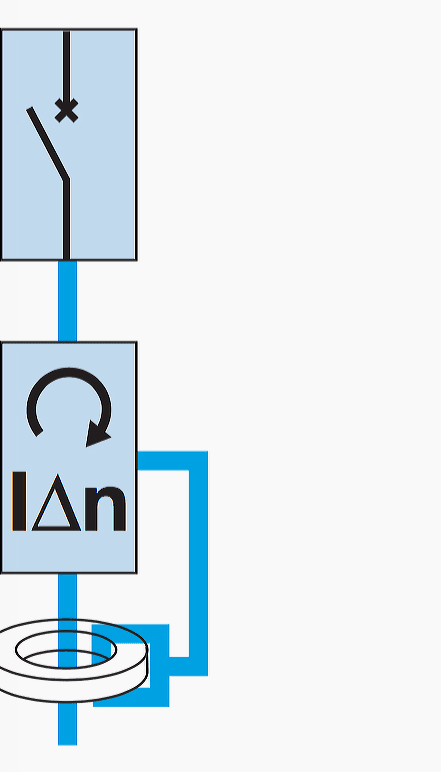

Earth leakage circuit breaker can be classified according to IEC 62020 or in the first case the relay is suitable for „monitoring“ the circuit and providing information about the network‘s insulation. In the second case the relay is appropriate to protect people against the effect of electric shock hazards.
According to new Annex M of IEC 60947-2, the Manufacturer of residual current relays must check and guarantee protection performance for the entire chain, composed by toroidal transformer + relay + shunt trip + circuit breakers!
In addition, they can be used only with circuit breakers certified by the manufacturer, who is responsible for the tripping time, considering the entire chain of components. The devices according to this new standard are tested by the factory in „ready to use“ configuration and they can make easier the installers‘ work easier.
Types of wave form detected by RCDs and classification
Residual current protective devices are distinguished from one another in respect of their suitability for detecting different forms of residual current.
Below is a table giving RCD classification according to the wave form of the earth leakage currents:
- Type AC – sensitive to alternating current only.
- Type A – sensitive to alternating and/or pulsating current with DC components.
- Type A to provide protection in case of alternating residual sinusoidal currents up to 1.000 Hz, pulsating direct residual currents and smooth direct residual currents.
- Type F, with rated frequency 50 Hz or 60 Hz are intended for installations when frequency inverters are supplied between phase and neutral or phase and earthed middle conductor and are able to provide protection in case of alternating residual sinusoidal at the rated frequency, pulsating direct residual currents and composite residual currents that may occur.


AC type RCDs are suitable for all systems where users have sinusoidal earth current. They are not sensitive to impulsive leakage currents up to a peak of 250 A (8/20 wave form) such as those which may occur due to overlapping voltage impulses on the mains (e.g.: switching of fluorescent bulbs, X-ray equipment, data processing systems and SCR controls).
‘A’ type RCDs are not sensitive to impulsive currents up to a peak of 250 A (8/20 wave form).
They are particularly suitable for protecting systems in which the user equipment has electronic devices for rectifying the current or phase cutting adjustment of a physical quantity (speed temperature, light intensity etc.) supplied directly by the mains without the insertion of transformers and class I insulated (class II is, by definition, free of faults to earth).
In addition to detecting residual current wave forms of type A, residual current protective devices of type B are used to detect smooth DC residual currents.
Type B RCDs are recommended for use with drives and inverters for supplying motors for pumps, lifts, textile machines, machine tools etc., since they recognise a continuous fault current with a low level ripple. Tripping values defined up to 2 kHz.
Type AC and A RCDs comply with IEC 61008/61009. Type B for RCDs is not mentioned in these reference standards: an international standard, IEC 62423, has been introduced in 2007, specifying additional requirements for type B RCDs. This new standard, IEC 62423, should only be referred to together with IEC 61008-1 (for RCCBs) and IEC 61009-1 (for RCD-blocks and RCBOs), this means that B type RCDs must be compliant with all the requirements of IEC 61008/9.
Additional two types of RCD
In addition there are other two type of RCDs according to the wave form of the earth leakage currents:
- Type F
- Type B+
Type F RCDs are for loads with single-phase inverters and similar equipment (e.g. modern washing machines), as an extension of type A. Type F RCDs, additional tests have been added to those for type A, in order to simulate the ground fault in presence of a single phase inverter.
It effectively fixes, in an “official” way, the problem of unwanted tripping with a non-selective RCD!
In IEC 61008-1 and IEC 61009-1 (RCDs for housholder and similar applications) only type AC and A RCDs are covered, types F and B are not mentioned. IEC 62423 ed. 2 covers both type F and B RCDs and it can only be used together with IEC 61008-1 and IEC 61009-1.
At the moment, type B+ are only introduced in a DIN VDE 0664-100 specification applicable in Germany.
Like type B residual current protection devices, type B+ residual current protection devices are suitable for use in alternating current systems. Tripping conditions for type B+ residual current protection devices are defined at up to 20 kHz and lie within this frequency range below a tripping value of 420 mA.
Summary for criteria: Types of wave form
In summary, to choose the right type of residual current device, two different aspects must be considered:
1. The type of RCD protection required:


2. The type of fault current wave form:
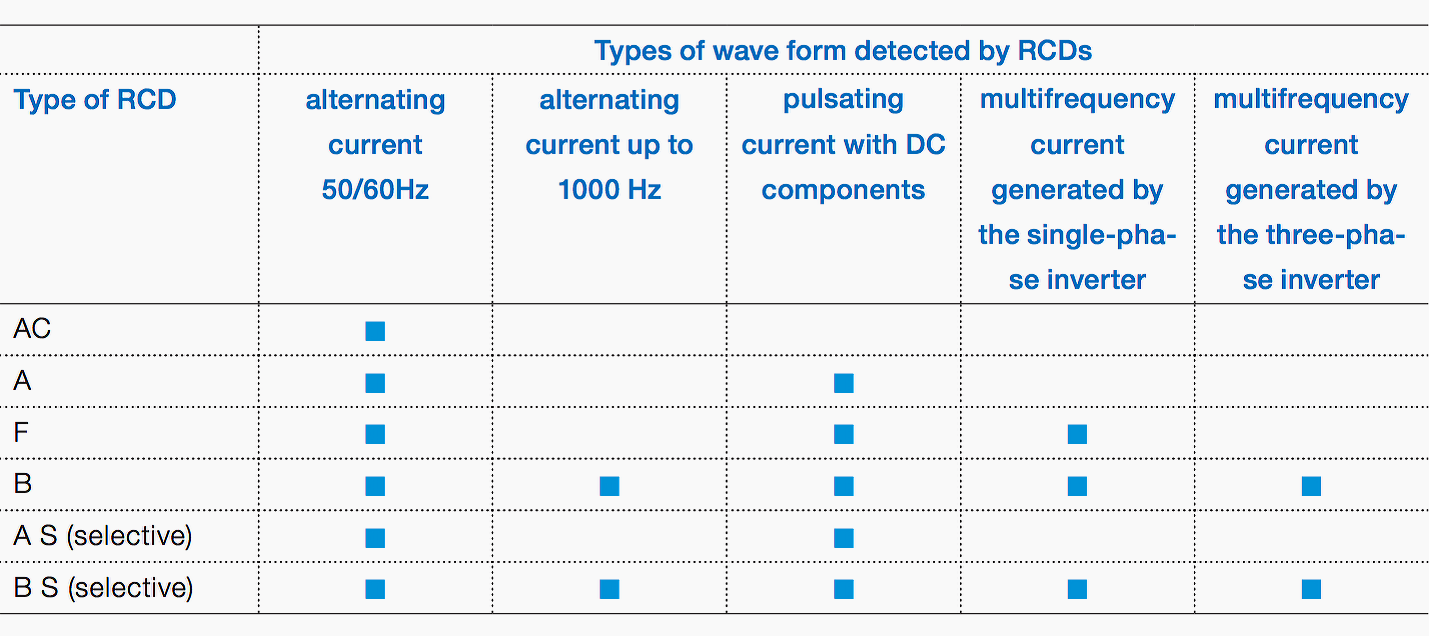

Related standards residual current devices
The relevant standards covering RCD products are as follows:
- IEC 61008-1 -Residual current operated circuit-breakers without integral overcurrent protection for household and similar uses (RCCBs) – General rules
- IEC 61009-1 – Residual current operated circuit-breakers with integral overcurrent protection for household and similar uses (RCBOs) – General rules
- IEC 60947-2 – Low Voltage Switchgear and Controlgear – Circuit Breakers
- Annex B, Circuit Breakers Incorporating Residual Current Devices
- Annex M, earth leakage relay
- IEC 62423 ed.2 – Type F and type B residual current operated circuit-breakers with and wit- hout integral overcurrent protection for household and similar uses
- IEC 62020 – Electrical accessories – Residual current monitors for household and similar uses (RCMs)
- IEC/TR 60755 ed 2 – General requirements for residual current operated protective devices
- IEC/TR 62350 – Guidance for the correct use of residual current-operated protective devices (RCDs) for household and similar use
Reference // Protection against earth faults with Residual Current Devices by ABB

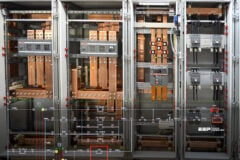




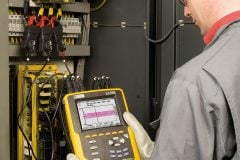

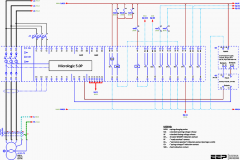
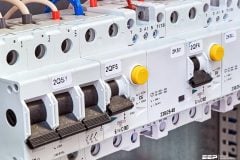

I’m always grateful for the knowledge I get from this platform. Thanks a lot indeed
Hello,
What’s the RCD current rating requirements for industrial (not domestic use) machinery use in Spain? Does anyone know? I have installed a system there but the customer is not sure whether to fit a 30mA or 300mA RCD on the socket. He’s getting conflicting advices too. Thanks for helping if you can :)
A lot of loads containing electronics now take asymmetric currents. The article talks about tripping on DC currents but can the asymmetric currents result in the core of the torroidal transformer saturating preventing the transformer working and tripping the circuit either in normal use or during fault conditions ?
To some extent the DC current resulting from the asymmetric load on the Live & Neutral should cancel out as the current flows in opposite directions through the core but is this sufficient to prevent problems ?
Hi…you chaps… if you write to me at my email address or france007@onthenet.com.au
I can take you through it.
I need a clarification that which rating leakage current of RCBO is suitable for 3phase welding machines. (30mA or 100mA or 300mA).
Please give your advice.
Regards
we are doing a construction project, what rating of RCCB can be used for AC distribution box?
This one is a pretty useful article. As Maurice has already said it would very helpful if a download of this article is made available.
I am locking for a RCD for the following electrical load 115VAC/10A/400Hz/3Ph. The load includes a fan motor
Please recommend a RCD module that comply with the requirements,
Thanks,
Arie
Question.
If an eqpt not fitted w/ RCD but has a reliable earth wire and let’s say a leakage current (mA generated by an inverter ) develops, will you get zap if you touch the eqpt?
In theory current seeks a path of least resistance so if we cannot feel the zap w/c one is correct?
1. No (zero) current will flow to your body because it rerouted to the low resistance earth wire
2. There is current will flow to your body (your body will be a second path) but you just cannot feel it because our body has high resistance?
Please discuss. Thanks
Dear Concern,
I want to know how to select RCCB, RCD, ELCB against MCCB ?
Mean 30A MCCB = RCCB? or RCD? or ELCB?
I am waiting for your reply.
Thank you.
Dear Sir,
My house does not have proper earthing. So i want to purchase havels 30 ma, 25 A, AC type RCCD. Will it protect us from severe shock. Please advice. No where i could get perfect clear answer.
Rgds
Sujeet Singh
Sujeet, if your house does not have proper earth, then an RCD or RCBO with 30mA protection may not function as the method for providing safety requires a measure of the flow of electricity between earth and phase cable to determine the leakage. When this leakage is 30mA, the device will trip. However if the earthing is incorrect, the unit to trip early, or not trip thereby not providing safety. To install the RCBO/RCD device, a connection is required for measuring the current flow. Please use a professional electrician, he should first check your house earthing and fix it, then install any RCBO/RCD is required.
Very infomative. Make provision for downloading of such materials, for academicians to use.